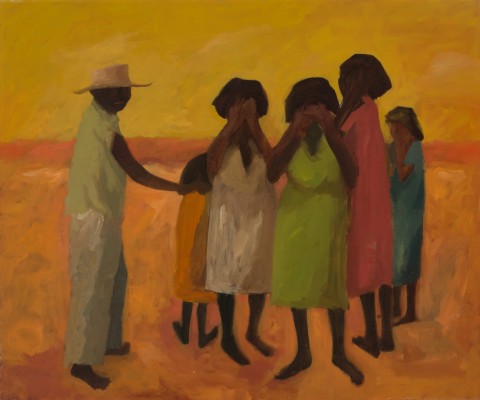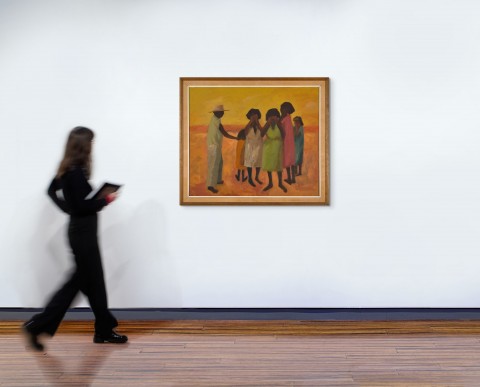THE MESSENGER, 1961
SAM FULLBROOK
oil on canvas
92.0 x 109.5 cm
signed indistinctly lower left: Fullbrook
South Yarra Gallery, Melbourne (label attached verso)
CARBA, Melbourne
Air Liquide Australia, Melbourne
Private collection, Melbourne, acquired from the above in 2007
Painting from the Pacific: Japan, America, Australia, New Zealand, Auckland City Art Gallery, Auckland, 25 July – 20 August 1961, cat. 64 (label attached verso)
We are grateful to John Cruthers for his assistance with this catalogue essay.
The 1950s saw the emergence of a number of artists who were lauded for their rugged individuality as much as their art. The list includes former pugilist Robert Dickerson; the self-sufficient Jon Molvig, handy with a longbow; and former underground miner Pro Hart. Sam Fullbrook was often included in this group but it was not how he saw himself: ‘A lot of people have described [me as] ‘that old bushman Sam Fullbrook’, but I’m no bushman. I was brought up in the heart of Sydney … Probably, I get that bushman bit because I’ve spent half of my life in the bush and I like living in the bush. … No, I’m not a bushman, I’m a painter. I’m a good painter.’1 After studying at the National Gallery School in Melbourne alongside John Brack and Fred Williams, Fullbrook began a decade of work and extensive travels that led him to Pilgangoora on the traditional lands of the Kariyarra people near Port Hedland in Western Australia’s Pilbara region. Here, he built a studio of stone, saplings and spinifex grass at the McLeod Native Co-operative, whilst he was employed by the McLeod Mining Company.
In spite of living within a disenfranchised community burdened by racial discrimination, Fullbrook found the Aboriginal way of life ‘very aristocratic compared to our own system…. Spiritually, they all had top hats.’2 He also began to paint them, but with empathetic dignity. These quietly moving images soon found success in Perth and beyond, with the actress Vivian Leigh purchasing ‘a picture of an Aboriginal girl cleaning a fish’ in 1959.3 Fullbrook’s respect for his subject is apparent in The Messenger, 1961, where the man on the left has been given the sad task of delivering bad news. With one hand gently comforting a child, the man silently gazes at the surrounding women who grieve in attitudes similar to those found in paintings of the lamentation of Jesus by Renaissance and Baroque artists such as Giotto, Mantegna and Rubens. The simplicity of the painting is deceiving as it is anchored by a precise design and illuminated by a sophisticated interplay of colour. Of similar works by Fullbrook, one reviewer noted that whilst the figures and their background were ‘partly described, partly dissolving’, it was their ‘effective relationship with their surroundings (which) gives them pictorial existence.’4 Examples of these include: Northwest landscape with Aborigines, 1955 (Queensland Art Gallery); Girl with kangaroo, c.1954 – 1959 (National Gallery of Victoria), and The head stockman, 1957 – 60 (National Gallery of Australia).
The Messenger was painted the year after Fullbrook’s return to Sydney, in a studio he had established next to the Grace Brothers department store on Broadway. That year also saw him mount exhibitions in Brisbane and Sydney, and he was included in a group exhibition of Australian artists at Raymond Burr Galleries in California. In 1963, Fullbrook was awarded the prestigious Wynne Prize at the Art Gallery of New South Wales (he won a second one the following year); and in 1974, he added the coveted Archibald Prize to his list.
1. Sam Fullbrook, interviewed by John Cruthers, December 1985, for the film The painters, the sculptors: Sam Fullbrook, Australia Council, 1986. Transcript provided to the author, courtesy John Cruthers.
2. ibid.
3. Sam Fullbrook. Quoted in: Beeby, R., ‘You don’t sell, you don’t eat’, The Age, Melbourne, 12 August 1985, p. 11
4. Henshaw, J., ‘Improbable assemblage’, The Bulletin, Sydney, 20 October 1962, p. 34
ANDREW GAYNOR


